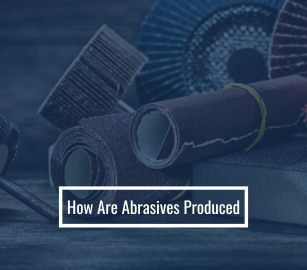
How Are Abrasives Produced

Abrasives are produced using corundum, aluminum oxide, or silicon carbide in a vitrified bond or resin bond, known as traditional abrasives. A brief description of grinding wheel production is provided below. This holds for all grinding instruments, including sharpening stones.
There are 5 steps in making grinding wheels:
- Mixing.
- Pressing.
- Fire and drying.
- Finishing.
- Quality Assurance.
HOW ARE ABRASIVES PRODUCED?
1. GRAIN AND BOND MIXING
The bond must be prepared before the first phase, which combines grain and bond. The bond's constituent parts are combined and ground. Clay, kaolin, and feldspar are common natural and synthetic mineral raw materials found in vitrified bonds, denoted by the letter "V." (glass-like frits).
A tool is used to combine the bond and abrasives grain to form the coated abrasives and bonded abrasives. To guarantee consistent quality, it is crucial to adhere to the proportions of the ingredients listed in the recipe. The second working stage, "pressing," takes the mixture after that.
2. GRINDING WHEELS BEING PRESSED
The necessary pressing mold is incorporated into the press. Finally, the combined material is poured uniformly into the press mold. Steady filling is essential to create a homogeneous, consistent grinding wheel. The grinding wheel is then pressed, but not yet fired, to release the so-called "Grünling." A cart is used to transfer this from the press properly.
3. WHEELS ARE DRYING AND FIRING
Unfired grinding wheels are sent to a drying oven after pressing. Here, grinding wheels are dried before use. The wheels are mounted on fire-resistant exchange carts and pushed into the kilns for burning. Firing methods require planning because they take time. Depending on the size of the grinding wheels, the firing process can take up to a week. The kiln must first be heated for several days to a firing temperature of roughly 1000–1300 °C for vitrified bonded grinding wheels (resin-bonded grinding wheels are burned or hardened at roughly 180 °C).
After maintaining this firing temperature for a predetermined time, the kiln gradually cools down. The grinding wheels cannot be removed from the kiln until after a certain cooling phase. These heated grinding wheels, however, can't be used in their current state and need finishing.
4. FINISHING
The finishing or post-processing of grinding wheels can be quite labor- and time-intensive, depending on the shape. There are various workstations where grinding wheels are reworked. The grinding wheel is planned, and the hole is drilled to the necessary inner diameter. The wheel is then ground at the circumference to the necessary outer diameter. With specialized dressing/profiling machines, grinding wheels with unique geometries, such as cup wheels or worm wheels for gear grinding, are profiled.
5. QUALITY ASSURANCE
Grinding wheels are examined in the last phase as part of our quality control process. At higher speeds (higher than working speed), we examine the dimensions, unbalance, and break resistance/strength. Several techniques are used to measure hardness. Grinding wheels that pass this type of testing are safely packaged and delivered.



































































